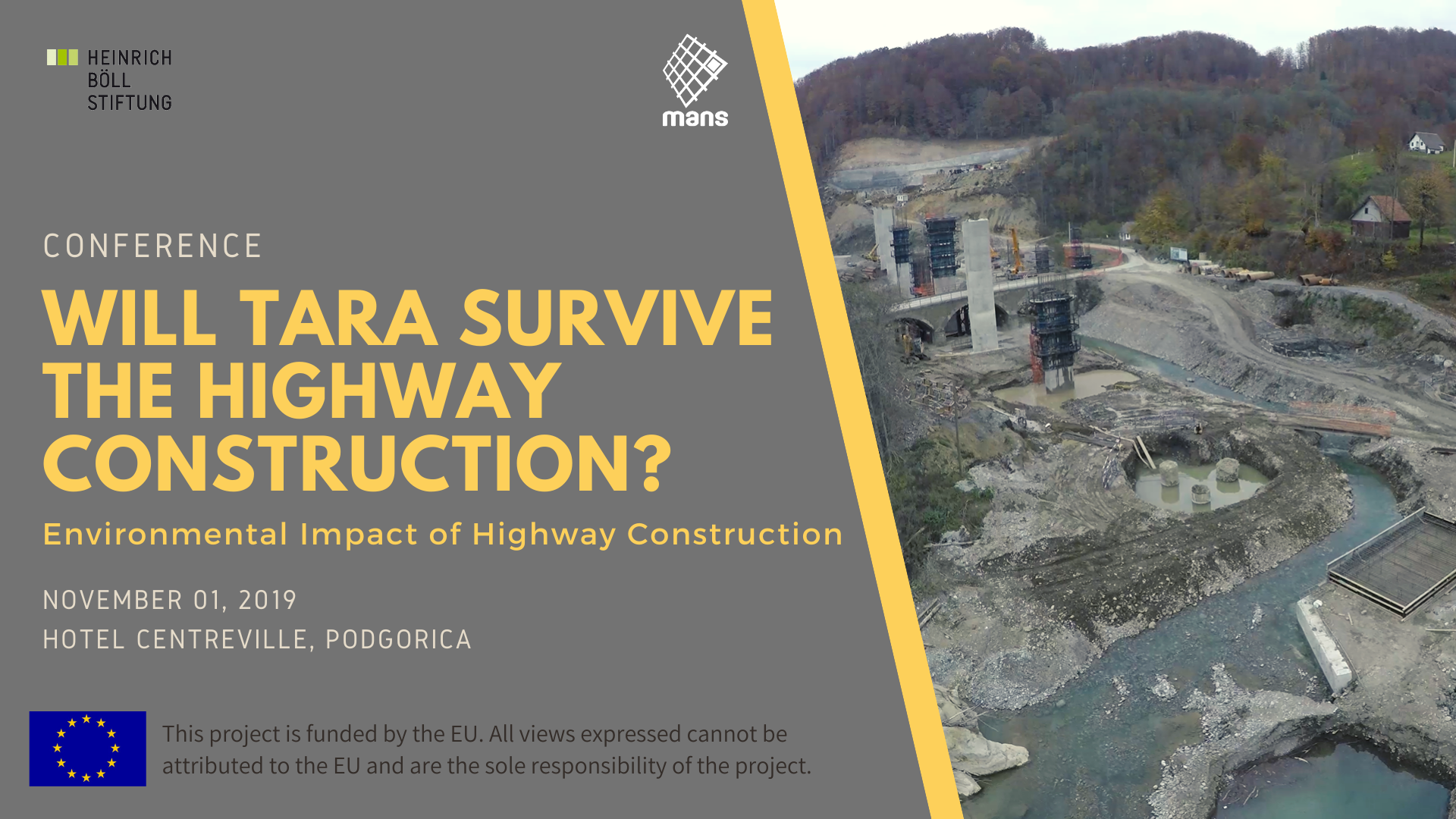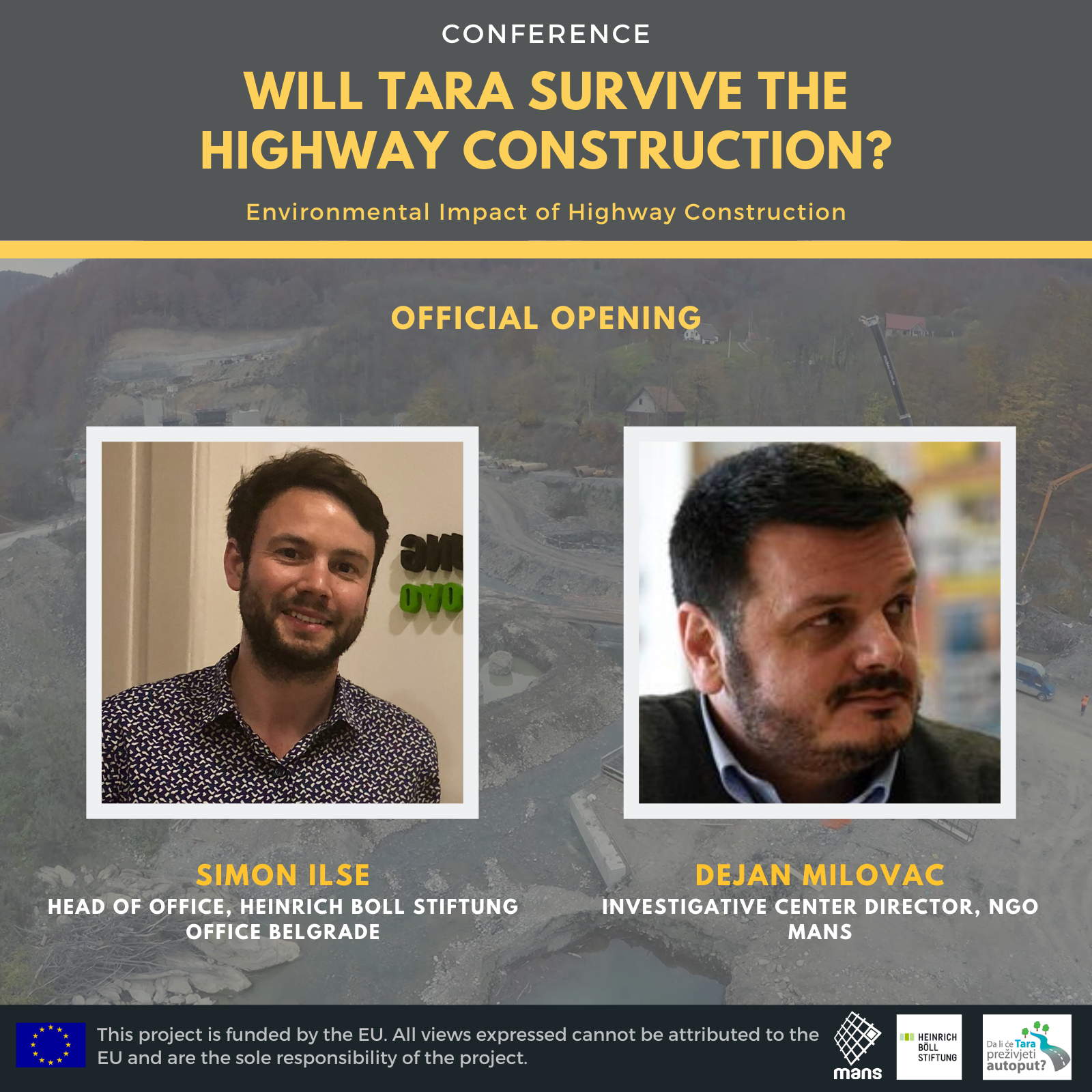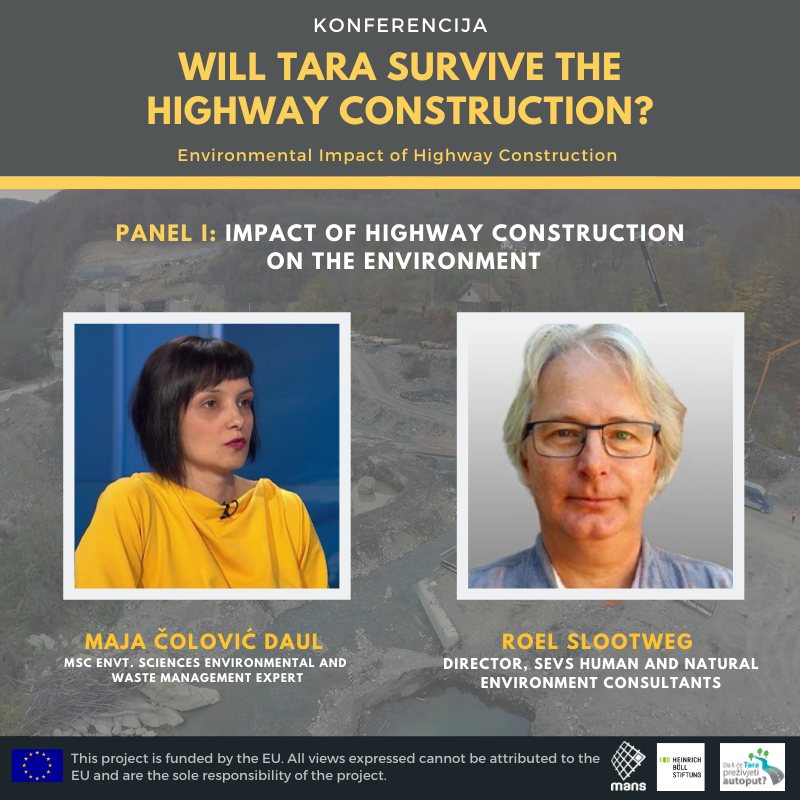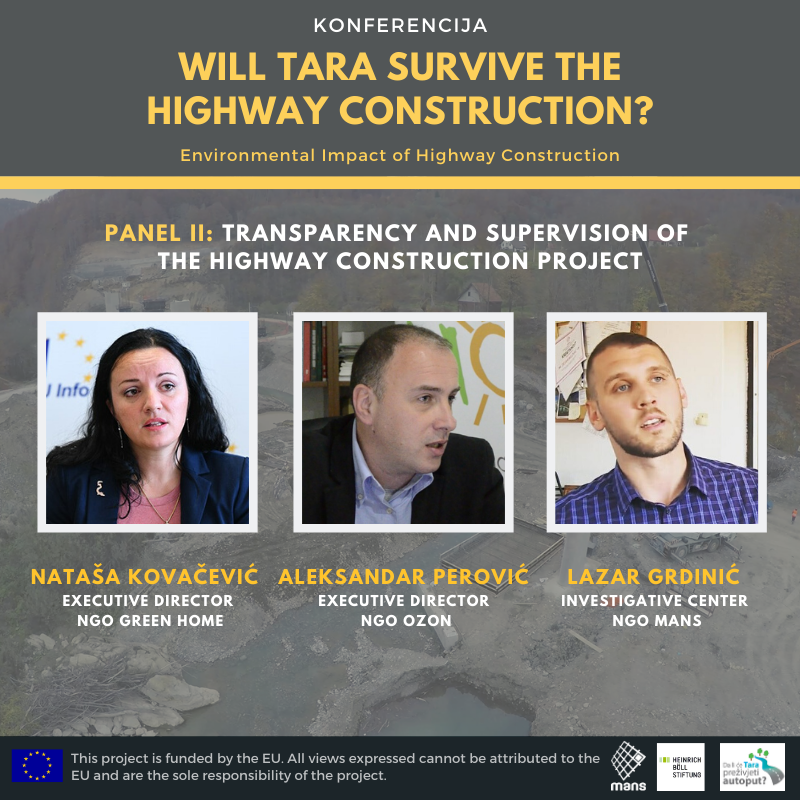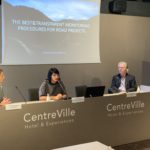Conference under the title “Will Tara survive the highway construction?” was held on Friday, November 1 in Podgorica, as part of the project supported by the European Union, in collaboration with Heinrich Böll Foundation.
Montenegro has a serious case of devastation of the multiply protected area – river Tara, which will be a major issue on its way towards the EU, as the state will not be able to close Chapter 27 until it resolves the chaos created by the construction of the highway, it was stated at the conference “Will Tara survive the highway construction?“, organised by MANS.
Simon Ilse, Head of Heinrich Boll Stiftung Office Belgrade, reminded that Montenegro was proclaimed an ecological state by its Constitution, however, from conversation with actors from civil society and environmental activists, he found that there were serious violations of this aspiration to be an ecological state, as well as that there was no respect for protected areas through the construction of small hydropower plants and industrial pollution.
“Things are not going in the right direction in spite of Chapter 27 for the EU integration being opened. When I look at this highway project, I am asking myself how the Government is planning to close this Chapter”, Ilse said at the opening of the conference.
He said there was plenty of room to talk about China’s Road and Belt initiative being implemented globally in a sustainable way.
“It does not look good at the moment, but I believe it is not too late, and that there can be some rehabilitation measures. It is clear that the Balkans need highways, but the question is how you do it”, Ilse said. In his words, civilian activists in Montenegro are not alone in protecting their livelihoods and the environment, instead, they belong to the larger European global green movement.
“You are not the enemies, but you are the real patriots of your countries, because you stand in and want to protect your country,” Ilse said.
Dejan Milovac, director of the MANS Investigative Centre, reminded that for the last two years MANS has been thoroughly engaged in the construction of the highway, which is the largest investment in the history of Montenegro, and at the same time it is a project that has an unprecedented environmental impact.
“We saw everything that has been done with the Tara River, but it is also a project where absolutely everything has been done to withhold key information from citizens and the interested public. It is known that Montenegro has a very infamous reputation for failed privatizations, but as never before, there is an absolute harmony between institutions of all three branches of government to withhold key information”, Milovac said.
He reminds that four years since the beginning of construction of the highway, citizens do not have the most important information about this project because everything was declared confidential. Among other things, the results of the work of the inspection are confidential, so it is unknown who is responsible for the devastation of Tara and who at the Ministry of Sustainable Development and Tourism (MSDT) remained silent on the devastation.
“Are the interests pursued, above all, by the Minister of Sustainable Development, and other government officials responsible for respecting the public interest, so great that the Government can afford not only to ignore citizens, civil sector and institutions, but also to ignore very specific recommendations from the European Parliament, the European Commission and UNESCO to stop the devastation of Tara immediately?”, Milovac asked.
According to him, a year since MANS has made first footage and recommendations to the Government, not only there have been no rehabilitation measures, but also no serious intentions or formal announcements of political willingness to end the devastation.
“On Monday, we visited the construction site and what we saw indicates a completely ignorant attitude towards UNESCO recommendations, primarily by MSDT”, Milovac said.
He added that a month ago MANS contacted MSDT, the Ministries of Transport and Finance, a number of permanent and newly formed institutions whose job is to monitor the construction of the highway to come to the conference, have their say, deny MANS’ allegations, but not only did no one gather the courage to come, but there was also a complete lack of sense of responsibility towards the citizens.
Panel I: Infrastructure and environmental protection – International experience and EU standards
Roel Slootweg, human and natural environment consultant from SevS organisation, presented key principles of European regulation in such projects, which is quality information, public participation and transparency in decision-making.
He said at the Panel I that he had been in Montenegro ten years ago, and was worried that there had been no progress and that there were still difficulties with regard to environmental impact assessment procedures.
Slootweg also pointed out that he was quite shocked by the video from Tara, especially given the downstream of this area, and stressed that Tara was a serious case of devastation and that the Government had to provide quality information, as this is one of the EU’s priorities.
“For me this was quite a shock. Tara is a serious case of devastation. The drone footage showed very clearly the chaos that has been made. The Government had to provide quality information as this is one of the EU priorities. Taxpayers with whose money the highway is built must have quality information. They have the right to know what is going on, whether the works are affecting the environment”, Slootweg said at Panel I of the conference, adding that the public must be able to go to court if they wish to improve something.
“First of all, I am talking about Aarhus Convention, the right of the community to know. In the EU countries, citizens have the right to information, transparency of the process and involvement in decision-making on major infrastructure projects. The recommendations of the EC, EP and UNESCO also refer to compliance with the environmental directives. In my country, failure to comply with these recommendations would result in court cases“, Slootweg stated.
He warned that delaying the rehabilitation plan could lead to a disaster, losing various opportunities and increasing of costs.
According to him, stream of the Tara River is covered with sediments, material and when the snow melts, there will be floods.
Maja Čolović Daul, environmental expert, pointed out that the money for the highway is not allocated by the Chinese, but by citizens of Montenegro.
According to her, Montenegro had a lot to learn from similar projects in the region, thus, she hopes that “Montenegro will wake up and react“.
She explained that such projects should take into account construction waste and materials, disposal sites, use of machinery (noise, vibration), mobile toilets, protected habitats etc.
“You cannot say ‘let’s do this so and we will implement rehabilitation measures later’. It costs a lot more then. Once something happens, there is no turning back”, Čolović Daul said.
She said that prior to beginning of the highway project in Montenegro, no soil analyses were done, so when one goes out into the field, they cannot compare the analysis with something that had been there before.
Panel II: Construction of the highway and its impact on Tara – Experiences of Montenegro
The Executive Director of NGO Green Home, Nataša Kovačević, reminded that environmental NGOs have been engaged in proving devastation of Tara for three years.
“So many mistakes have been made and such devastation has been done to the river, which has six levels of protection. The river is degraded and looks like an ordinary pond”, Kovačević said at panel II.
She added that the situation is getting worse, landfills are 20 meters or more long and there is no biodiversity at the bottom.
“Tara is so dug up that the entire communities are wiped out”, Kovačević said, adding that the problem is the removal of cut wood assortments in the area, which are being transported by trucks without plates into an unknown direction.
“This will be an obstacle to closing Chapter 27”, Kovačević said.
The documentation says that the revitalization of the devastated area will cost from 250 to €500 thousand, and that it will be completed by 2027.
“I think this amount is unrealistic and that the cost of repairing the damage will be 10 times higher, i.e. it will cost millions. Even after the rehabilitation, Tara will not be the same as it was before the start of the highway construction project. What is noticeable is that the situation has changed significantly in the past three years, the embankments are larger, dumps also, access roads are becoming recognizable, while the river is unrecognizable. In the area where the works are performed, the river is sterile, there is no river biodiversity”, Kovačević pointed out.
The executive director of Environmental Movement Ozon, Aleksandar Perović, said that the money for protection had already been spent, “through various installations, as is already the case with us.”
He believes rehabilitation will cost significantly more than the estimated € 500,000.
“Nothing has been done right. The very absence of representatives of the Government here best indicates how prepared they are for any kind of dialogue”, Perović said.
He added that the same situation is with the Parliament, which has never convened a session on Tara.
“is is not just about impact on the nature, but on society as well. There are people here who are used to living with the river and living in peace. Their traditional way of life is disturbed. We cannot replace the life of that population”, Perović said.
According to Lazar Grdinić of the MANS Investigative Centre, the construction waste is still being disposed into Tara and various types of waste are ending up on its banks, which is quite rude given how important this topic has been in the last year and how many efforts environmental organizations have made to at least address liability for damage that is clearly done and which will most certainly remain even after the end of the project.
“It’s all done through illegal landfills at several locations on Tara. The first Construction Waste Management Plan provided for 9 landfills. Of those 9, two were supposed to be near Tara, but they were never opened. Instead, in the meantime, the Remediation Plan was adopted, which provided that all material excavated from the tunnels would be deposited on the banks of the Tara”, Grdinić explained.
He said that any talk of river dikes and slopes that should protect residents from flooding falls apart as soon as one comes to the site and sees how large the embankments are.
“Regarding other irregularities, we announced last year that wastewater that ends up in Tara does not meet the quality requirements and thus pollutes the water. UNSECO has warned our Government that it is not yet clear what the impact will be downstream and that it must be addressed as soon as possible, and we have the situation that, even though we have collectors, they do not function and wastewater is flowing directly into Tara”, Grdinić said.
He reminded that MANS had filed two criminal charges within a year for irregularities related to environmental protection, for pollution of the protected area.
“In a year we have not heard a single word from the State Prosecutor’s Office, and in the meantime, we have sent supplement to these criminal charges with new evidence and footage”, Grdinić said.

